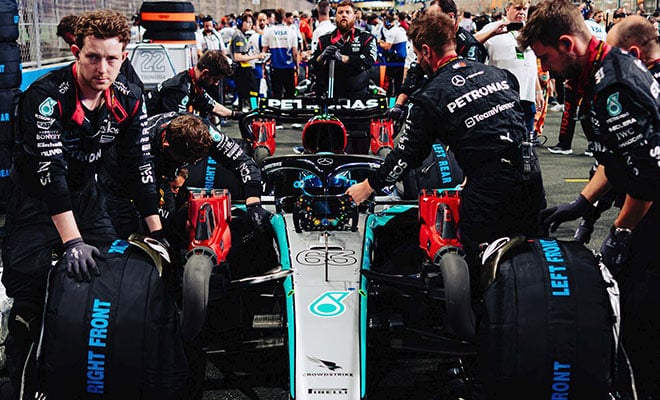Mercedes F1 reflects on their strategic decision during the Jeddah GP, admitting a missed opportunity with divergent driver strategies.
At the Jeddah Grand Prix, Mercedes F1 opted for divergent strategies for its drivers, leaving Lewis Hamilton on track during a Safety Car deployment. Andrew Shovlin, the team’s Performance Director, now acknowledges the team’s regret over this decision, citing the risk-reward analysis at the time appeared to justify the strategy split.
“In hindsight, yes, we should have done it,” Shovlin stated. “What we didn’t know then was whether there would be another incident. And what else we were unaware of was how resilient the tires would prove to be.”
“The Safety Car’s arrival on the seventh lap fell precisely at the moment we needed to decide whether to pit both cars. Had it been on the eighth or ninth lap, we probably would have.”
“For Lewis, trailing in the second car, the downside was the need to build a gap, which you’re not allowed to do. You can’t force others off the track when there’s a Safety Car.”
“Obviously, they can’t overtake you, and you would be penalized for blocking. Thus, while George was being serviced in the pit, Lewis would have had to wait.”
Hoping for Another Safety Car
It’s important to note that before falling in behind the Safety Car, it’s the time delta that matters, not the distance between cars. Interestingly, Mercedes has often employed this tactic when Valtteri Bottas was Lewis Hamilton’s teammate during his dominant phase but seems hesitant to do so now.
However, Shovlin also mentions the time loss due to the number of cars in the pit lane, and this rationale is entirely logical: “There are also cars navigating the pit lane, and if there’s a queue forming, we wouldn’t be able to release George, and Lewis would get stuck.”
“This was simply because we thought he would lose time. However, we also anticipated that if another Safety Car was deployed later in the race, it could work to our advantage.”
“And then there are cars on different strategies. But at that moment, the deployment happened just when we would have chosen one strategy over another, and two laps later, we might have pitted both.”
Lack of Confidence for a Double Stop?
Shovlin admits the team was concerned about time loss, despite their proven ability to execute flawless double stops in the past: “It’s a bit more complicated for the team because they have to prepare two sets of tires in the pit lane.”
“Therefore, more tires are involved, and there’s a lot of work because when you pit one car, you have the rear jack man in place, who then has to move away quickly after releasing it so the next car can enter.”
Even though the team was confident they could manage, they feared the risks were too high: “However, we train for such scenarios. The problem is that it can’t be done as quickly. The risk is losing time.”
“And as mentioned before, if there’s a line of cars navigating the pit lane and the first car can’t exit, then the second car must wait. And when it’s ready, if there are more cars, it must wait even longer.”
Mercedes Strategy Regret Jeddah. Mercedes Strategy Regret Jeddah
- ReadMore>Bearman Chooses #87 for Future F1 Dreams
- Following us on Facebook and Twitter.
